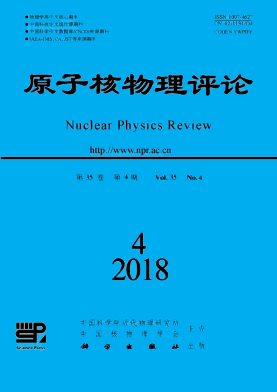|
[1]
|
DANYSZ M, PNIEWSKI J. Philos Mag, 1953, 44:348. |
|
[2]
|
HASHIMOTO O, TAMURA H. Prog Part Nucl Phys, 2006, 57:564. |
|
[3]
|
GAL A, HUNGERFORD E V, MILLENER D J. Rev Mod Phys, 2016, 88:035004. |
|
[4]
|
NAGAE T. Prog Theor Phys Suppl, 2010, 185:299. |
|
[5]
|
HAO J, KUO T T S, REUBER A, et al. Phys Rev Lett, 1993, 71:1498. |
|
[6]
|
HIYAMA E, MOTOBA T, RIJKEN T A, et al. Prog Theor Phys Suppl, 2010, 185:1. |
|
[7]
|
SCHAFFNER-BIELICH J. Nucl Phys A, 2008, 804:309. |
|
[8]
|
XING X Y, HU J N, SHEN H. Phys Rev C, 2017, 95:054310. |
|
[9]
|
SUN T T, XIA C J, ZHANG S S, et al. Chin Phys C, 2018, 42:025101. |
|
[10]
|
HAYANO R S, ISHIKAWA T, IWASAKI M, et al. Phys Lett B, 1989, 231:355. |
|
[11]
|
PROWSE D J. Phys Rev Lett, 1966, 17:782. |
|
[12]
|
DANYSZ M, GARBOWSKA K, PNIEWSKI J, et al. Nucl Phys, 1963, 49:121. |
|
[13]
|
AOKI S, BAHK S Y, CHUNG K S, et al. Prog Theor Phys, 1991, 85:1287. |
|
[14]
|
KHAUSTOV P, ALBURGER D E, BARNES P D, et al. Phys Rev C, 2000, 61:054603. |
|
[15]
|
AOKI S, BAHK S Y, CHUNG K S, et al. Prog Theor Phys, 1993, 89:493. |
|
[16]
|
NAKAZAWA K, ENDO Y, FUKUNAGA S, et al. Prog Theor Exp Phys, 2015, 2015:033D02. |
|
[17]
|
MOTOBA T, BANDŌ H, IKEDA K. Prog Theor Phys, 1983, 70:189. |
|
[18]
|
HIYAMA E, KAMIMURA M, YAMAMOTO Y, et al. Phys Rev Lett, 2010, 104:212502. |
|
[19]
|
ZHOU X R, SCHULZE H J, SAGAWA H, et al. Phys Rev C, 2007, 76:034312. |
|
[20]
|
LU B N, ZHAO E G, ZHOU S G. Phys Rev C, 2011, 84:014328. |
|
[21]
|
HIYAMA E, KAMIMURA M, MOTOBA T, et al. Phys Rev C, 1996, 53:2075. |
|
[22]
|
ZHOU X R, POLLS A, SCHULZE H J, et al. Phys Rev C, 2008, 78:054306. |
|
[23]
|
LÜ H F, MENG J. Chin Phys Lett, 2002, 19:1775. |
|
[24]
|
SONG C Y, YAO J M. Chin Phys C, 2010, 34:1425. |
|
[25]
|
LU W L, LIU Z X, REN S H, et al. J Phys G:Nucl Part Phys, 2017, 44:125104. |
|
[26]
|
REN S H, SUN T T, ZHANG W. Phys Rev C, 2017, 95:054318. |
|
[27]
|
SUN T T, LU W L, ZHANG S S. Phys Rev C, 2017, 96:044312. |
|
[28]
|
BANDŌ H, MOTOBA T, ŽOFKA J. Int J Mod Phys A, 1990, 05:4021. |
|
[29]
|
GAL A, SOPER J M, DALITZ R H. Ann Phys (N.Y.), 1971, 63:53. |
|
[30]
|
MILLENER D J. Nucl Phys A, 2008, 804:84. |
|
[31]
|
ISAKA M, KIMURA M, DOTE A. Phys Rev C, 2011, 83:044323. |
|
[32]
|
BROCKMANN R, WEISE W. Phys Lett B, 1977, 69:167. |
|
[33]
|
MAREŠ J, JENNINGS B K. Phys Rev C, 1994, 49:2472. |
|
[34]
|
SHEN H, YANG F, TOKI H. Prog Theor Phys, 2006, 115:325. |
|
[35]
|
LIU Z X, XIA C J, LU W L, et al. Phys Rev C, 2018, 98:024316. |
|
[36]
|
WIRTH R, GAZDA D, NAVRATIL P, ét al. Phys Rev Lett, 2014, 113:192502. |
|
[37]
|
SERT B D, WALECKA J D. Adv Nucl Phys, 1986, 16:1. |
|
[38]
|
MENG J, ZHOU S G. J Phys G:Nucl Part Phys, 2015, 42:093101. |
|
[39]
|
SUN T T. Sci Sin Phys Mech Astron, 2016, 42:012006. (in Chinese) |
|
[40]
|
BRÜCKNER W, FAESSLER M A, KETEL T J, et al. Phys Lett B, 1978, 79:157. |
|
[41]
|
LONG W H, MENG J, VAN GIAI N, et al. Phys Rev C, 2004, 69:034319. |
|
[42]
|
SUN T T, HIYAMA E, SAGAWA H, et al. Phys Rev C, 2016, 94:064319. |
|
[43]
|
FORTIN M, AVANCINI S S, PROVIDÊNCIA C, et al. Phys Rev C, 2017, 95:065803. |
|
[44]
|
NAGAE T, MIYACHI T, FUKUDA T, et al. Phys Rev Lett, 1998, 80:1605. |
|
[45]
|
DOVER C B, GAL A. Prog Part Nucl Phys, 1984, 12:171. |
|
[46]
|
NAGELS M M, RIJKEN T A, DE SWART J J. Phys Rev D, 1975, 12:744. |






 甘公网安备 62010202000723号
甘公网安备 62010202000723号 DownLoad:
DownLoad: